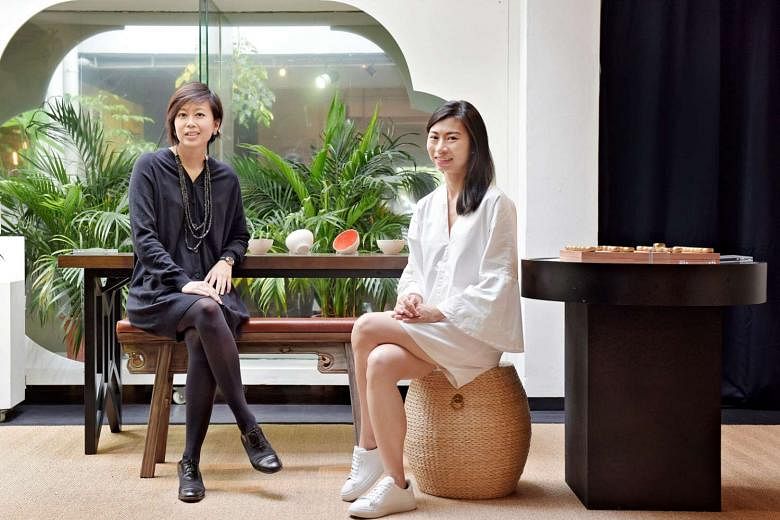Q What was the inspiration behind Scene Shang?
PAMELA In 2007, Jessica and I were in Shanghai on separate internship programmes, and we were really attracted to the mix of heritage and cosmopolitan vibe that the city had. It's the old and the new coming together. We share the same appreciation for the Chinese culture and the city inspired us. JESSICA There's also the mix of East and West. Being Singaporeans, we are exposed to both Eastern and Western influences, and in Shanghai we felt we could tap both cultures to create something interesting.
But we were interns then, and didn't have the skills or know what to do. So we returned to Singapore; Pam worked in a bank and I was an interior and graphic designer.
Q What made you start the business subsequently in 2014?
JESSICA As an interior and graphic designer, I shopped for furniture with some clients. One of them liked Chinese furniture, but we could not find anything that was more contemporary which could fit into the modern-day home.
So I suggested adding traditional Chinese brass knobs or handles - which I had gathered from Shanghai - to the carpentry. I started doing this for more clients and they really liked these little touches.
I started questioning the work I was doing and wondered why so many people came to me asking for Scandinavian design when we have such a rich culture of our own.
I realised I could play a role, as a designer, in extracting the beauty from Chinese furniture and giving it a contemporary voice.
PAMELA For me, I enjoyed what I did in wholesale banking, but I did not see myself doing it for the rest of my life. I was promoted, and it meant a lot more responsibilities and moving to a different stage of my career, if I had stayed.
That got me thinking "it's now or never". I think that was the defining moment. The job provided stability but fundamentally I was looking for something more.
So we left our jobs after five years, went to Shanghai again around 2012, 2013 to learn about the furniture market, and met many craftsmen. We decided that Jessica could create the designs and get the craftsmen to execute them.
We came back to Singapore, launched the brand and worked out of a studio in Institution Hill.
Q What are some of Scene Shang's signature pieces?
PAMELA One of our popular pieces is the Shang System, which won a special commendation at the 2014 President's Design Award.
It takes inspiration from the Ming dynasty and features a hand- carved, stackable set of drawers. Clients can customise the piece, choosing from various colours and components such as trays and drawers.
There's also the Jia Ju range, which draws upon memories and emotional bonds that people have with certain pieces of furniture as they were growing up.
Q What are your considerations in designing furniture?
JESSICA For the Jia Ju collection, we spoke to people about their feelings and memories of furniture they played with as a child, and what they would consider as an heirloom.
We noticed that people developed feelings for certain pieces of furniture, for example, a rattan rocking horse, which still looks good in a home today but may not be so functional now that you're grown up. That gave us the idea to create the Jia Ju Rocking Stool. PAMELA We don't see furniture design as following a trend, nor is it seasonal. We mainly try to create pieces that are versatile, that fit smaller homes today and hopefully something that people would take with them when they move, or pass down to other family members - pieces that evoke fond memories.
Q How has business been since the opening of the new store in Beach Road last April?
PAMELA The store is 1,000 sq ft, it is bigger than the pop-up store we had previously in Millenia Walk. However, I think we are still quite a small set-up.
Business has been good so far and we turned in profits last year. For the first quarter this year, we are already doing better than the last quarter of 2016, a busier time due to the festive shopping.
Better sales aside, I think we also take a more prudent approach to our operations in that most of our furniture is made-to-order, so we don't hold a lot of inventory.
Q What are your plans for the business in the next 12 to 24 months?
PAMELA I had anxiety dreams before launching the business. The worries are different now, they're about scaling up and what are the next steps.
Now that more people know about the brand, there are higher expectations to meet, from what we have to offer to service and product quality.
We hope to go regional by the end of next year, looking mainly at Asian markets, and also step up on our e-commerce platform.
JESSICA As we think about expansion, we will also look at getting a trademark registration for our brand and applying for intellectual property rights for the Shang System.


